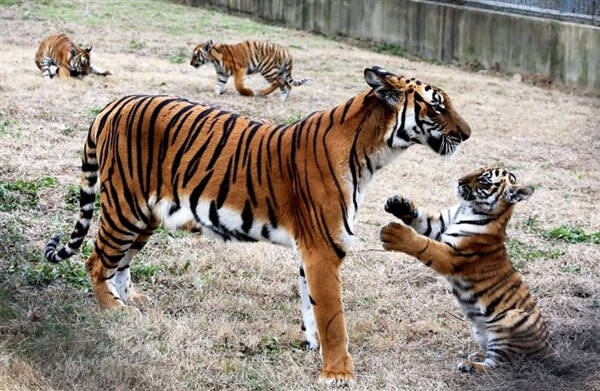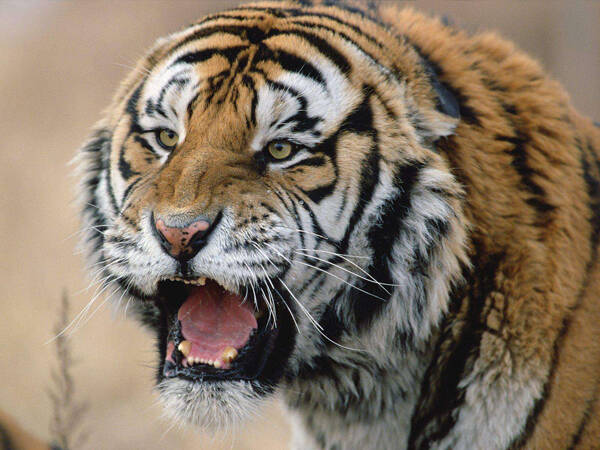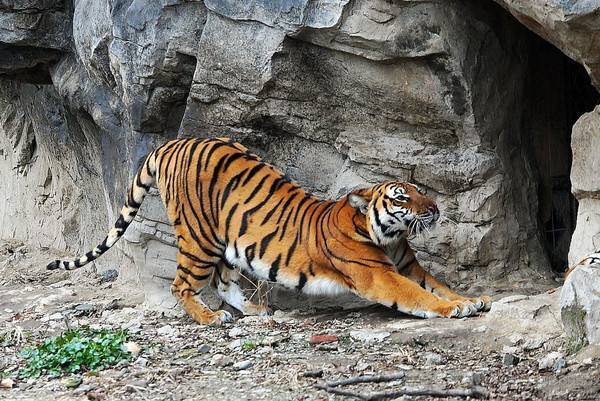Panthera tigris amoyensis
IUCN
LCBasic Information
Scientific classification
- name:Panthera tigris amoyensis
- Scientific Name:Panthera tigris amoyensis ,south China tiger,Chinese tiger, South China tiger, Xiamen tiger,Amoyensis
- Outline:Carnivora
- Family:Schizopoda Felidae Panthera
Vital signs
- length:2.3-2.5m
- Weight:120-150kg
- lifetime:20-25years
Feature
It is a subspecies of tiger unique to China and is extinct in the wild.
Distribution and Habitat
South China tigers were once found in almost every forest in China, and they were the most numerous. They were distributed far beyond South China, including the vast areas of East China, Central China, and Southwest China, and even in some areas such as Southern Shaanxi, Eastern Gansu, Western Henan, and Southern Shanxi. Today, the possibility of the existence of wild South China tigers is extremely small, and many experts believe that South China tigers are extinct in the wild.
South China tigers are typical mountain forest-dwelling animals, living in tropical rainforests and evergreen broad-leaved forests in southern China. They also often appear in mountain deciduous broad-leaved forests and mixed coniferous and broad-leaved forests such as ridges, shrubs, and rocky or gravel ponds.
Appearance
South China tigers are more primitive than other tiger species, with a larger ratio of skull length to skull width, a slender body, and a thin abdomen. They have a round head, short ears, strong limbs, a long tail, a lot of milky white on the chest and abdomen, and an orange-yellow body with black horizontal stripes.
South China tigers are small and are one of the smallest subspecies of tigers. .The male tiger is about 2.5 meters long from head to tail. It weighs about 150 kilograms. The female tiger is about 2.3 meters long from head to tail, with a tail length of 80-100 centimeters and a weight of about 120 kilograms.
There are short and narrow stripes on the fur of South China tigers, and the spacing between the stripes is larger than that of Bengal tigers and Siberian tigers. Diamond stripes often appear on the sides of the body. It is closer to the direct ancestor of tigers, the ancient Chinese cat.
Details
The South China tiger (Latin name: Panthera tigris amoyensis) is a subspecies of tiger unique to China. It is only distributed in China and lives in central and southern China. It is also called the "Chinese tiger" and is extinct in the wild.

South China tigers mainly live in forests and mountains in southern China. Although South China tigers do not like long-distance swimming, they can swim across narrow straits, so they also appear on islands like Xiamen. They live alone, not in groups, and are active at night. They have a well-developed sense of smell, are agile, and are good at swimming, but not good at climbing trees. They are similar to other tiger subspecies.
South China tigers mainly prey on ungulates, and their favorite prey is about 30-400 pounds. They feed on herbivorous animals such as wild boars, deer, and roe deer; male South China tigers will attack larger prey such as black bears and Malay bears. Generally speaking, a tiger needs at least 70 square kilometers of forest to survive, and must also have 200 sika deer, 300 antelopes and 150 wild boars. Wild South China tigers eat fresh meat, and their prey includes wild boars, bison and deer. They weigh 30-900 kilograms and have disappeared in the wild.

The gestation period of the South China tiger is about 103 days, and on average, two or three cubs can be born each time. Under normal circumstances, weaker South China tigers only give birth to 1-3 cubs each time, while those with better physique may have 2-4 cubs per litter. The highest record of births: 5 cubs per litter. The maximum age recorded is about 24 years old (female). The pedigree number of this individual is "25". It was captured in the wild in Hunan in 1966 when it was about 2 years old and sent to Changsha for captivity. It was transferred to Chongqing in 1980 and transported to Luoyang in 1982. It died on June 9, 1988, having lived in captivity for 22 years.
In order to promote the protection of South China tigers, the State Post Bureau of China issued a set of two special stamps of "South China Tiger" on August 23, 2004. The names of these two stamps are South China Tiger, with face values of 80 cents and 2 yuan respectively.

In January 2020, Wangcheng Park Zoo in Luoyang City, Henan Province, bred three new South China tigers, two females and one male, bringing the total number of South China tigers in the zoo to 42. On May 8, 2021, the female South China tiger "community" in Wangcheng Park successfully gave birth to three tiger cubs (two males and one female). Considering the limited energy of the female tiger and insufficient milk, the breeder decided to adopt artificial breeding for the three tiger cubs. The weight of these three South China tiger cubs when they were born was: 1090 grams for the eldest, 977 grams for the second, and 900 grams for the third. The breeder formulated a breeding plan based on the physical characteristics of each tiger cub, feeding small amounts and multiple times a day to ensure the digestion and absorption of the South China tiger cubs. At the same time, bone meal, vitamins, liquid calcium tablets and other nutritional elements are added to the diet every day to promote the physical development of the South China tiger cubs.
From 1990 to 1992, the Ministry of Forestry and the World Wildlife Fund conducted a nationwide survey of wild South China tigers and their habitats, but no live wild South China tigers were found. However, based on the traces and feces found, it is estimated that there were 20-30 South China tigers at the junction of Guangdong, Hunan, Jiangxi and Fujian in my country at that time. The actual number may be even less. In 2000-2001, the State Forestry Administration and WWF conducted a large-scale survey of wild South China tigers and their habitats across the country, but no wild tigers were found. After this survey, some foreign scholars believed that wild South China tigers were extinct. In the winter of 2007, the South China Endangered Animal Research Institute carried out the "Field Survey of Wild South China Tigers in Northern Guangdong" project, but ultimately found no traces of wild South China tigers. In 2008, when the "Zhou Tiger" incident occurred in Shaanxi, the expert investigation team sent by the State Forestry Administration also stated that there were no wild South China tigers in Zhenping County. The possibility of the existence of wild South China tigers is already very small. Because the reproduction of species requires the existence of natural populations, natural populations must also maintain a certain number of individuals and keep genes at a sufficient heterozygous level so that the population will not suffer from inbreeding depression due to inbreeding. Since the original distribution area of South China tigers has not seen traces of South China tigers for many years, the possibility of discovering South China tiger populations is even slimmer. Therefore, many experts believe that the natural population of South China tigers has become extinct.

As of September 2010, 16 zoos across the country kept South China tigers. Including: Luoyang Wangcheng Park, Shanghai Zoo, Suzhou Zoo, Guangzhou Zoo, Chengdu Zoo, Chongqing Zoo, Fuzhou Zoo, Nanchang Zoo, Guangzhou Xiangjiang Wildlife World, Shanghai Wild Animal Park, Shenzhen Wildlife Park, Guiyang Forest Wildlife Park, Changsha Ecological Zoo, etc. As of October 2010, there were about 110 South China tigers in captivity in the world. As of January 2022, there were 65 South China tigers in Wangcheng Park Zoo in Luoyang City, Henan Province, ranking first in the country. The main South China tiger protection and breeding bases are: China South China Tiger Suzhou Breeding Base, North Guangdong South China Tiger Domestication and Breeding Research Center, Fujian Longyan Meihuashan South China Tiger Breeding Base.

Listed as one of the ten critically endangered species by the International Union for Conservation of Nature
Listed in Appendix I of the CITES Convention
Listed as a first-class protected animal in China.
Listed in the 2012 Red List of Threatened Species of the World Conservation Union (IUCN) ver 3.1 - Extinct in the wild.
Protect wild animals and eliminate game.
Maintaining ecological balance is everyone's responsibility!








